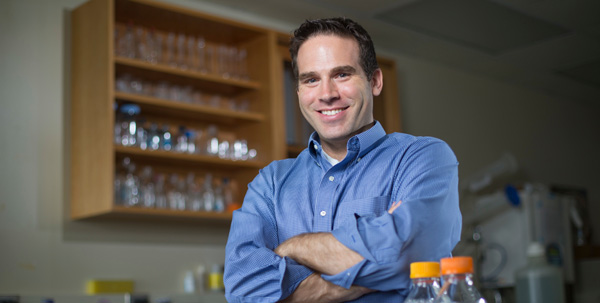
Looking for a Cure from the Inside Out
Extending the life of those afflicted with muscular dystrophy is one of Joshua Selsby’s research passions.
Selsby, an associate professor of animal science, has spent his career studying muscle and ways it can be damaged. Since 2006, he’s been looking for ways to preserve muscle in boys who suffer from the genetic disease.
Duchenne muscular dystrophy mostly affects boys, with one in 3,500 to 5,000 born with the disease. As preschoolers they begin to experience muscle weakness because an abnormal gene interferes with the production of a protein needed to form healthy muscle. Patients get progressively weaker, and usually by the age of 12 or 13 they will be in wheelchairs. Symptoms can lead to death in their 20s due to respiratory or heart failure, as their diaphragm or heart muscles weaken.
Since 2009, Selsby and collaborator John Quindry at the University of Montana have been looking for a practical way to turn on a pathway thought to have therapeutic potential for those affected by this disease. After finding no pharmaceuticals available to safely activate this pathway, they turned to the study of a nutraceutical called quercetin. Nutraceuticals are plant-derived supplements that may have physiological impact. Quercetin is derived from many plant sources such as apples, peppers, tomatoes and leafy greens.
Their 10-month study uses multiple pairings of quercetin with other compounds. So far, Selsby says quercetin doesn’t provide the “Wow!” he was looking for in skeletal muscles, but there might be some “real promise” for the heart. In addition to investigating muscular dystrophy, he says he finds the way heat stress affects muscle fascinating.
“I’ve developed an independent line of research to better understand what heat does to muscle that may cause damage,” Selsby says.
The hope is lessons learned in the study of dystrophic skeletal muscle may also apply to heat stressed muscle and may, for example, decrease oxidative stress caused by environmental hyperthermia, says Donald Beermann (’71 animal science), chair of the animal science department.
“The research tools Dr. Selsby uses to study muscular dystrophy are also used to investigate and understand the inflammatory signaling pathways and changes in energy, metabolism and mitochondria function in skeletal muscle associated with heat stress,” says Beermann.
Heat stress represents a significant human health concern as well as recurrent burden that detracts from growth efficiency in animal production. By better understanding hyperthermic muscle injury, there is the possibility this research will serve the dual purpose of decreasing human suffering as well as improving agricultural profitability and ensuring food security.
Selsby joined the department in 2008. He teaches graduate-level physiology and muscle biology courses and advises undergraduate students. He plans to continue both lines of research with the hope of improving lives through decreased disease burden and improved food security and agricultural profitability.



